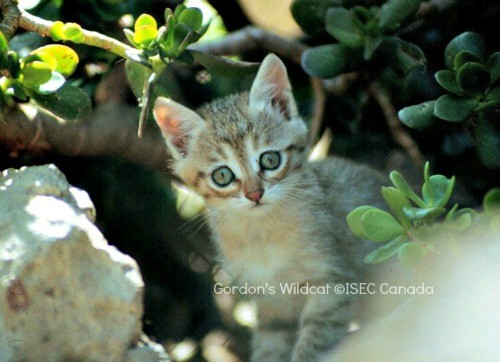Distribution of the Wildcat is extensive, but despite this relatively little is known about the ecology and behaviour of the various populations inhabiting diverse habitats. Few observations have been made on wildcats inhabiting the Arabian Peninsula, especially on the particularly small subspecies occurring in the United Arab Emirates and the Sultanate of Oman, the Gordon’s Wildcat Felis lybica gordoni.
Only a single study by means of telemetry established home range size and daily movement as well as denning behaviour of one female over the period of 14 months and for one male for 1.5 months in the desert surrounding the Breeding Centre for Endangered Arabian Wildlife, Emirate of Sharjah (Phelan & Sliwa, 2005, 2006).
The female’s range was 52.7 square km, and that of the male was 28.7 square km. These home ranges are exceptionally large compared to cats in forest or grasslands in Europe or Africa. Considering the large areas required for their survival, the increasing human encroachment has serious implications for their conservation.
Five years after the completion of the study, the male’s range had been entirely replaced by a dump and an industrial area. Urbanization also increases the population of feral domestic cats and contact with local people, who see all predators as threats.
The range of this wildcat subspecies, encompassing the Sultanate of Oman and some areas in the United Arab Emirates (UAE) is small and it can easily go extinct. It can also be considered an endangered subspecies for its liability to hybridize with feral domestic cats. Only a few purebred specimens may be left and hybrids, sometimes found hundreds of kilometres away from either water or the nearest Bedouin encampment, are difficult to detect. Gordon’s wildcats are also directly prosecuted by Bedouin and their habitat disturbed and altered through increasing development of the desert.
Nearly extinct in the wild, Gordon’s Wildcats are one of the most endangered subspecies of the Wildcat. In 1986, a breeding program was initiated in Abu Dhabi, with a captive male and a wild caught female. Owners of this colony became concerned that the entire subspecies could be wiped out by a catastrophe and sought to establish breeding programs in other areas, sending cats to Germany and California. An International Studbook is maintained by Cologne Zoo in Germany.
Back to the Wildcat page.

Pat Bumstead
Thank you for letting us know about the cats in Washington. There used to be a small breeding population in southern California, but we didn’t know about these cats.
Kyndal
There are Gordon’s cats being properly cared for at the Wild Felid Advocacy Center on Harstine Island in Washington State. I’ve been there twice and they truly love the cats they rescue, receive no pay, and even rescue snapper turtles that get “too old” for their owners. They are well worth a visit!
Pat Bumstead
We know nothing about any F.s. gordoni being imported to Washington State.
Katie
Two in Washington State…Illegally imported. Do you know the entry point, and do you have any other details?
edwardesmith
There are two captive Gordon’s cats in Washington State.